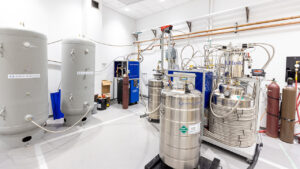Posted on December 6, 2023 in ASRC News, Structural Biology Initiative

A recapture system at the CUNY ASRC saves money and an endangered element.
A helium recapture system used by Graduate Center scientists since 2021 has saved thousands of dollars by recycling a dwindling natural resource. Supported by a grant from the National Institutes of Health (NIH), the system captures and recycles close to 90% of the helium used by five machines in the Nuclear Magnetic Resonance facilities at the Graduate Center’s Advanced Science Research Center (CUNY ASRC) and the City College Center for Discovery and Innovation.
“Helium is a nonrenewable resource, plain and simple,” says Professor Kevin Gardner, founding director of the Structural Biology Initiative at the CUNY ASRC, who authored the $170,000 NIH grant with former Research Associate Professor James Aramini. “There is a finite amount of it that the world extracts from the ground, typically as a byproduct of natural gas extraction. We put it into balloons, we put it into medical devices, we put it in whatever. When those things are exhausted, they end up releasing the helium into the atmosphere, and off it goes into outer space. Obviously, balloons aren’t something we’d be concerned about, but medical devices are.”
Helium’s usefulness derives in part from the fact that, like other noble gases, it is chemically unreactive and thus reliably stable. It can also be cooled to -269 Celsius — almost 500 degrees below zero Fahrenheit — making it a critical tool for lowering the temperature of wires and magnets to the point where they become superconductors. Such superconductors are used in a range of scientific and medical contexts.
“Helium is able to be chilled to near absolute zero — basically almost as cold as you can get,” Gardner says. “Materials at those temperatures get certain unique properties. In particular, certain kinds of wires get absolutely no resistance in them. And those superconducting wires are at the heart of some very strong electromagnets in MRIs and related technologies.”
Among the instruments that require helium to cool magnets are nuclear magnetic resonance spectrometers, instruments that, according to Gardner, “determine the atomic structures of proteins, letting us understand how they work normally, how they’re broken in disease, and how we might be able to fix them with novel drugs or engineer them into novel tools for biotechnology.” The recycler at the CUNY ASRC is currently in use on five spectrometers, Gardner said.
Because of its scarcity, Gardner notes, the price of helium has long been volatile, and access to it has sometimes had a political valence. He cites the Helium Act of 1925, pointing out that the restriction on U.S. helium exports that it imposed was in part what caused German engineers to use flammable hydrogen to lift the ill-fated Hindenburg airship. But, as an article in Science noted earlier this month, the U.S. government has been emptying its helium reserves since the 1990s. As the U.S. seeks to sell remaining stores of the element and its distribution system, scientists who use the gas in research see cause for concern.
“The national reserve is almost depleted,” Gardner says. “Instead, we’re picking up helium now as a byproduct of natural gas extraction. There are some operations in parts of Central and Eastern Europe and the Middle East. But those are areas of the world that sometimes get politically complicated to get things in and out of, and so, as a result, we see wild oscillations in the market. Some facilities have had to shut down instrumentation rather than keep it going. To restart is extremely costly, to the tune of hundreds of thousands of dollars — something to be avoided unless it’s a true emergency.”
Maintaining a private stockpile of helium, Gardner says, would be extremely challenging. Insulating liquid helium well enough to prevent boil-off is very difficult, and storing sufficient quantities of helium as a gas would require vast amounts of space, since “a lot of gas gives you only a little bit of liquid.”
Thus, the recycler. Gardner says the short-term goal is to expand the device’s capacity by 50%, a change that would allow for more flexibility in scheduling recycling and use, avoiding disruptions to research. And he emphasizes that the success of the project has been the result of a broad-based group effort.
“Institutional funds for installation were provided both by the Graduate Center and by City College of New York,” he says, “and I really applaud [Distinguished Professor of Chemistry and Biochemistry] Ruth Stark — she was critical in helping get the CCNY side together – as well as Dr. Nina Gray, who was then the ASRC’s executive director. Technical and support staff from both the ASRC and CCNY have also been essential to this instrumentation working as well as it has, particularly Research Assistant Professor Dr. Denize Favaro, in her role as the ASRC’s Biomolecular NMR facility director.”
His conclusion: “It does take a village to recover liquid helium.”
Published by the Office of Communications and Marketing
